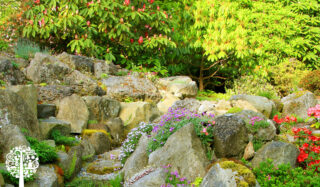Do you have a lot of rocks on your property? No matter the size, rocks are a beautiful element in any landscape. Beyond looking good, they serve a purpose in the garden: Heat!
Creating Microclimates
An area surrounded by rocks or another hardscape, such as a brick wall, a patio, or paved walkways, becomes a microclimate. That means the environment in these areas will differ from the larger space around them.

These ‘hard’ structures attract sunlight and hold and radiate heat. As a result, the air around them is warmer, and the soil and anything you plant there will be too.
Heat Island Effect
They call this the ‘heat island effect’ in urban areas. Buildings, paved roads, and sidewalks packed close together trap heat, making summer unbearable hot. Many cities strive to reduce the heat island effect by planting more vegetation.
But if you already have many plants growing, live in an area that’s cooler or has a shorter growing season, you can use hardscapes for extra thermal mass in the garden.
Rock Walls
We uncovered many massive rocks when we built our new home last summer. Instead of paying to haul them away, we had them incorporated into our landscape. They’re being used in retaining and decorative walls throughout the property.

There’s so much heat that bounces off these south-facing rock walls! In the spring, they were the first areas to be exposed as the snow began to melt. Given our shorter growing season, I want to use the extra warmth to my advantage and build my vegetable gardens nearby. (More on that project in a future post.)
I’ll grow heat-loving plants like tomatoes, peppers, and eggplant in raised beds in front of the rock wall. They’ll get a lot of warmth during the day, and the best part is the rocks will continue to radiate heat at night, keeping my babies nice and toasty.
Hardscape Hunting
So, while planting or designing your garden space, look for hardscapes you can incorporate into the plan. You don’t need massive boulders for extra thermal mass. Fountains, bird baths, terracotta or stone pots, the driveway, and the exterior wall of your building will all attract and give off extra heat, lending your garden a helping hand.
This is a brilliant strategy, especially in colder climates. I have (literal) tons of rocks on my hillside, being on the Canadian shield, and we have built many rock walls for our fruit trees and berries. It makes them sweeter. In fact we have a stone house with grape arbors that are very productive even with our short season. There is a wonderful article about the old fruit walls near Paris that were used to grow soft fruit. These were the precursors for greenhouses, as the simply leaned old window against them and voila! Here is the article: https://www.lowtechmagazine.com/2015/12/fruit-walls-urban-farming.html
So informative, Marci! Thank you for sharing.